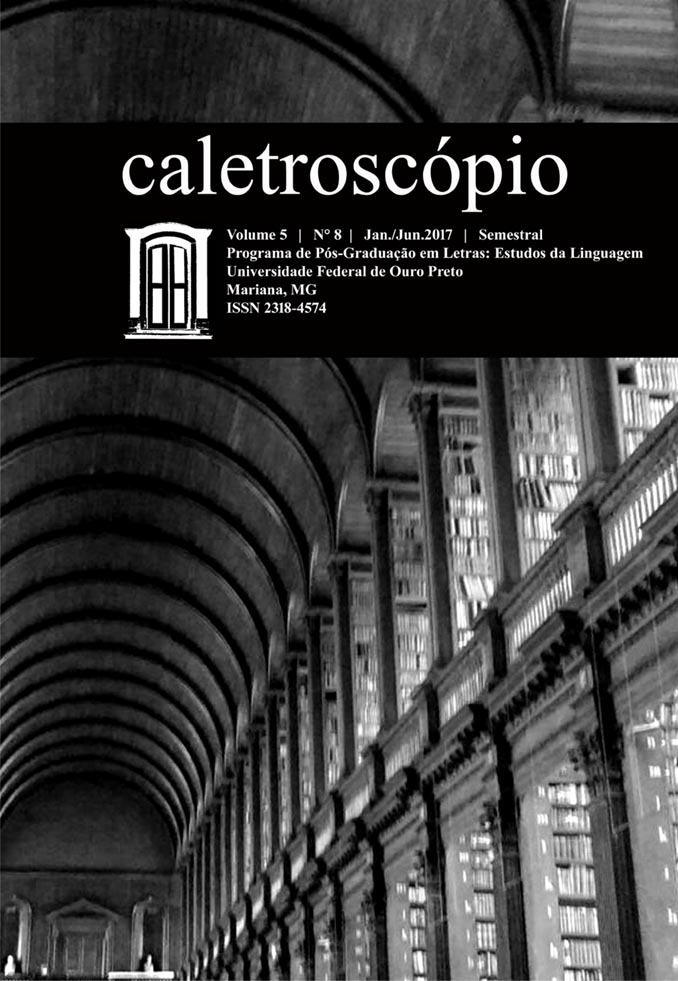O Definido Fraco Em PB: Uma Perspectiva Experimental
Abstract
Faz-se relevante a discussão sobre o papel do artigo definido no valor composicional de uma sentença. Carlson e Sussman (2005) defendem a existência do definido fraco, que não teria a unicidade proposta por Russell (1905). Aguilar-Guevara e Zwarts (2013) defendem que o fraco seria equivalente ao genérico, mantendo a unicidade. Este artigo investiga o comportamento do definido fraco, contrastando com o genérico em português brasileiro por reaplicação de experimentos originalmente em língua inglesa de XXX. Nosek et al. (2015) afirma que, para o contexto atual científico, a reaplicação é essencial, pois confere confiabilidade e auxilia a promover inovações. A reaplicação em português também se faz importante por permitir observar o definido fraco no contexto desta língua. Foram reaplicados quatro experimentos off-line e os resultados obtidos corroboram XXX, há três tipos de definido: regular fraco e genérico. Os experimentos também permitiram observar diferenças qualitativas relacionadas às diferenças entre as línguas.
Downloads
References
ABBOT, Barbara. Reference. Oxford, Oxford University Press, 2010.
AGUILAR-GUEVARA, Ana; ZWARTS, Joost. Weak definites and reference to kinds. Proceedings of SALT, Ithaca, NY: CLC Publications, no.20, p. 179-196, 2010.
AGUILAR-GUEVARA, A.; ZWARTS, J. Weak definites refer to kinds. Weak definites across Languages, Recherches Linguistiques de Vincennes, v. 42, p. 33–60, 2013.
ALMOR, Amit. Noun-phrase anaphora and focus: The informational load hypothesis.
Psychological Review, Providence, no. 106, p. 748–765, 1999.
BEYSSADE, Claire.; OLIVEIRA, Roberta Pires de. Weak definites across Languages. [S.l.]: Recherches linguistiques de Vincennes. v. 42, 2013.
__________________________________. Weak definites refer to kinds. In: BEYSSADE, Claire; OLIVEIRA, Roberta Pires de. Weak definites across Languages. Recherches linguistiques de Vincennes, no.42, p.33-60, 2013.
CANÇADO, Márcia. Manual de semântica: noções básicas e exercícios. Belo Horizonte, Editora UFMG, 2005.
CARLSON, Greg. Generic reference. In: BROWN, Keith. (Ed.). The Encyclopedia of Language and Linguistics. Amsterdam, Elsevier, 2005.
CARLSON, G. et al. Weak definites noun phrases. Proceedings of NELS, Amherst, v. 36, p. 179–196, 2006.
CARLSON, G. et al. Weak definites as a form of definiteness: Experimental investigations. Weak definites across Languages, Recherches Linguistiques de Vincennes, v. 42, p. 11–32, 2013.
CARLSON, G.; SUSSMAN, R. S. Seemingly indefinite definites. In: KEPSAR, . M. R. S.(Ed.). Linguistic Evidence. Berlin: de Gruyter, 2005.
CHIERCHIA, Gennaro. Semântica. Campinas, Editora Unicamp, 2003.
DONNELLAN, K. “Reference and Definite Descriptions.” In Semantics: An
Interdisciplinary Reader in Philosophy, Linguistics and Psychology, 100–114,1966.
FREGE, Gottlob. Lógica e filosofia da linguagem. São Paulo, Ed. da Universidade de São Paulo, 1978.
GUNDEL, J. K.; HEDBERG, N.; ZACHARSKI, R. Cognitive status and the form of
referring expressions in discourse. Language, v. 69, n. 2, p. 274–307, June 1993.
HEIM, I. The semantics of definite and indefinite noun phrases. In: HANKAMER, Jorge. (Ed.). Outstanding dissertations in Linguistics. New York, Garland Publishing Inc., 1982.
IOANNIDIS J. P. A. Why most published research findings are false. PLoS Medicine, v. 2, n. 8, p. 696-701, agosto, 2005.
KLEIN, N., GEGG-HARRISON, W., CARLSON, G. e TANENHAUS, M. K. Experimental investigations of weak definite and weak indefinite noun phrases. Cognition, v.128, p.187-213, 2013.
NOSEK, B. A et al.. Estimating the reproducibility of psychological science. Science, v. 349, n. 6251, p. aac4716-1 - aac4716-8, 28 agosto, 2015.
ROBERTS, C. Uniqueness in definite noun phrases. Linguistics and Philosophy, Netherlands, 2003.
RUSSELL, B. On denoting. Mind, New Series, Oxford University Press, v. 14, p. 479–493,1905.
SCHWARZ, Florian. 2013. Different Types of Definites Crosslinguistically. Language and Linguistics Compass Volume 7, Issue 10, pages 534–559
STRAWSON, P. On referring. Mind, New Series, v. 59, p. 320–344, 1950.
The publication Caletroscopio shall retain for a period of three years all authorial rights for works accepted for publication: articles, reviews, translations, etc. Outside this restriction, these works are licenced through Licença Creative Commons-Atribuição-NãoComercial-SemDerivações 4.0 Internacional.
Upon expiry of this period, in the event that the author publishes the text, even when making alterations to the original, we would ask authors to include as a footnote, the information that a previous version of the article was published in the Revista Caletroscópio, citing the appropriate references.


